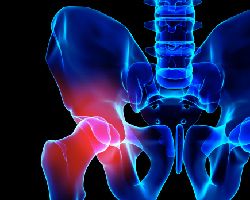Health library
Back to health libraryLearn the anatomy of the hip

The hip is your second largest joint. Its ball-and-socket configuration normally provides impressive range of motion.
Your hip is a big joint that has some big jobs—from helping to support your body's weight to helping you get around. Learning the parts of the hip joint and how they work may help you understand a major cause of hip pain.The anatomy of the hip
The hip joint is a ball-and-socket that joins the thighbone and the pelvis. This ball-and-socket arrangement is what gives a healthy hip a greater range of motion than, say, a knee joint, which works like a hinge. (The shoulder is another ball-and-socket joint.)
Here's a closer look at the two main structures of the hip:
- The ball is the femoral head (the bone at the top of your thighbone, or femur).
- The socket is the acetabulum (part of the pelvis bone into which the femoral head fits).
Other structures support and stabilize the hip joint, as well as allow for movement. For example:
Cartilage is a smooth, slippery substance that cushions the bones and allows the joint to move smoothly.
The synovium is a membrane that lines the hip joint. The synovium makes fluid that lubricates the joint.
Ligaments are strong bands of tissue that help connect the hip bones together. They also form a capsule around the joint, which includes the synovium.
The hip joint has many muscles that allow it to move. These include the gluteal muscles of the buttocks, the adductor muscles of the inner thigh, the quadriceps on the front of the thigh and the hamstrings on the back of the thigh.
What can go wrong with hip structures?
The hip joint is a source of pain for many people. One major cause of hip pain is osteoarthritis, according to the American Academy of Orthopaedic Surgeons (AAOS).
Osteoarthritis is known as a wear-and-tear type of arthritis because it usually happens with age. Over the years, the cushioning cartilage that allows the femoral head to move easily within its socket starts to wear down. When there is less of this slippery tissue, the bones start to rub against one another. The bones may also form growths, called spurs.
The result? Hip pain and stiffness that can eventually make it harder to perform daily activities, like walking. The pain may be felt in the groin or thighs or radiate to your buttocks or knee.
Arthritis can affect other joints too. But because it's a weight-bearing joint (like the knees), the hip is more prone to arthritis than are non-weight-bearing joints like the hands or shoulders, according to the AAOS.
Don't put up with hip pain
Although hip arthritis is more common with age, it isn't a normal part of aging.
If you have hip pain, you should see your doctor. Get a proper diagnosis, and find out what might be done to ease your pain.
Additional source: Arthritis Foundation
Reviewed 5/13/2025
